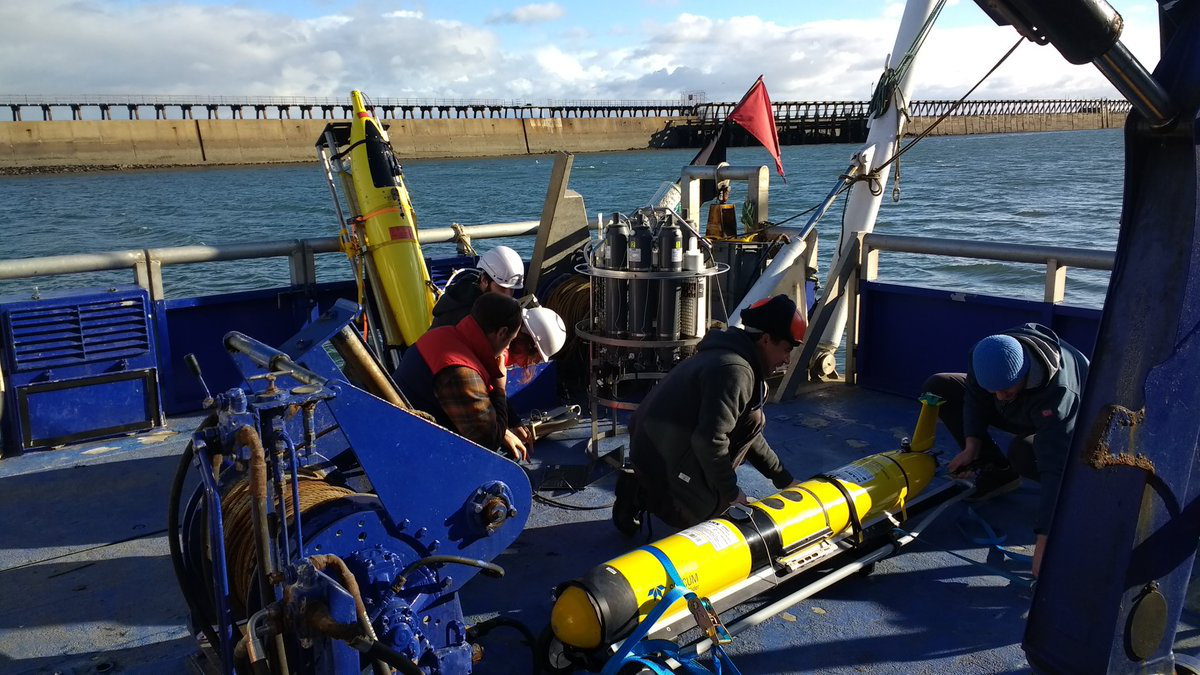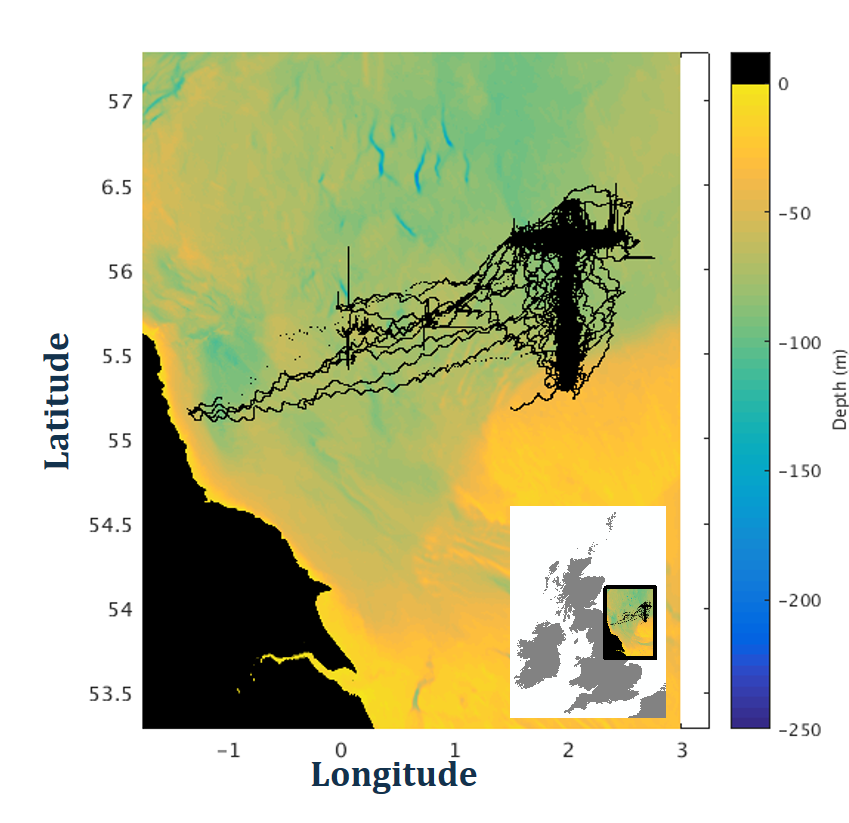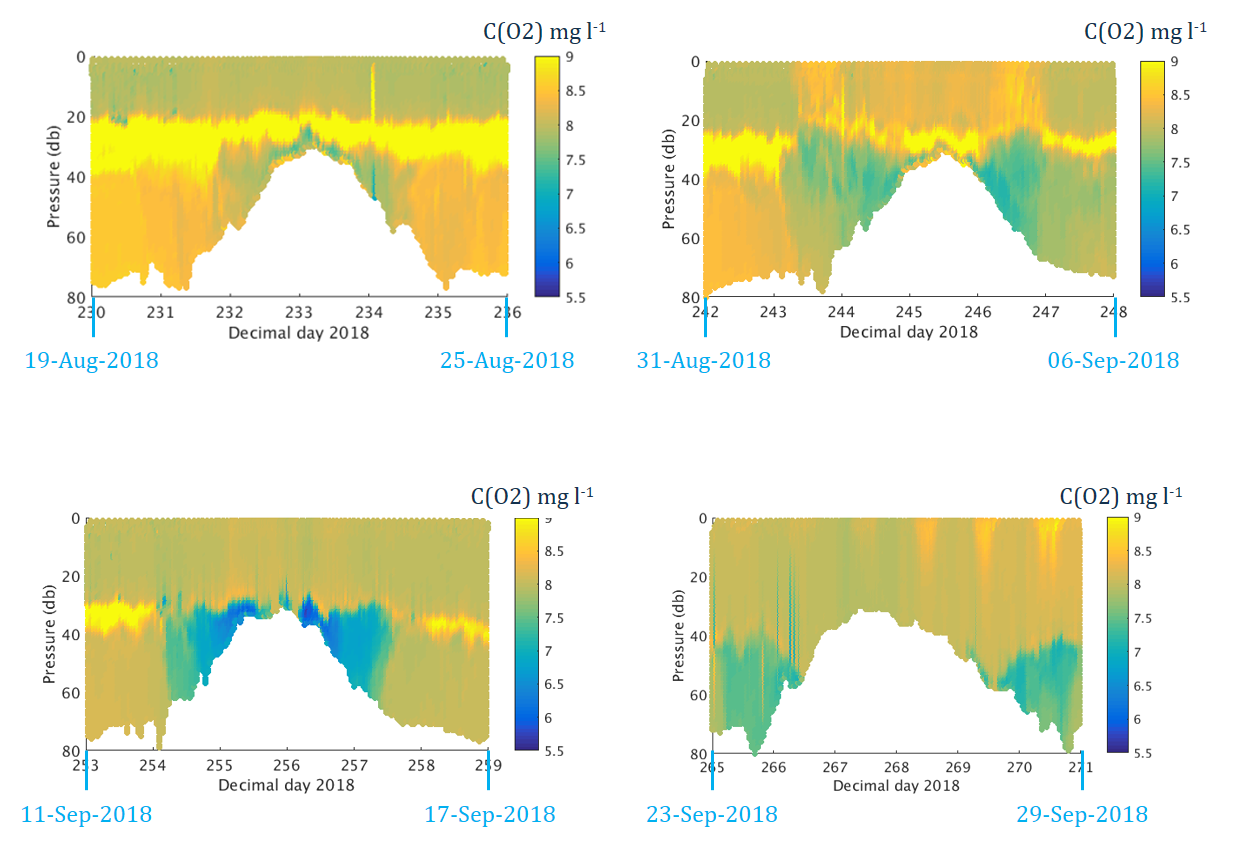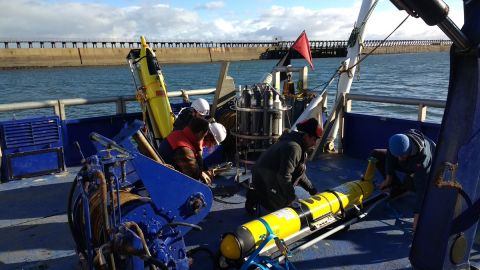The application of novel technologies to collect dissolved oxygen measurements in the North Sea
Dissolved oxygen in seawater enables healthy ecosystems to thrive. Concentrations of dissolved oxygen can be reduced by the breakdown of excessive phytoplankton growth which is associated with eutrophication. Warming ocean temperatures are also resulting in lower concentrations of dissolved oxygen (ocean deoxygenation).
The AlterECO project (“An alternative framework to assess marine ecosystem functioning in shelf seas” www.altereco.ac.uk) was designed to improve the spatial and temporal coverage of measurements of dissolved oxygen in the North Sea and to gain a better understanding of the processes driving oxygen depletion and marine health in shelf seas. To achieve this the AlterEco project has developed a novel monitoring framework using the latest autonomous oceanographic technologies, ocean gliders (Figure 1).

Figure 1: The AlterECO team preparing the ocean gliders on the RV Princess Royal (University of Newcastle) at Blyth.
These autonomous vehicles can be deployed for periods of several months to collect observations at a single location (referred to as a “virtual mooring”) or along a transect (with possible repeat visits). The ultimate goal of the project is to improve the understanding of key shelf sea ecosystem drivers, together with providing sufficiently high temporal and spatial resolution of the underlying processes to better understand the impacts of year-to-year variability of the shelf sea ecosystem.
Between October 2017 and May 2019, more than 10 ocean gliders measured dissolved oxygen and other relevant oceanographic variables, using a range of onboard sensors. Two transect lines (one north-south and one east-west, Figure 2) were maintained over the study, coinciding with associated research cruises carried out by the MRV Scotia (Marine Scotland) and the RV Endeavour (Cefas).
The AlterECO gliders captured important transitional periods in the North Sea, including the onset and breakdown of seasonal water column stratification (Figure 3). The oxygen concentrations are high at the start of spring, and become more depleted as the oxygen is taken up by respiration. Close to the sea bed, the vertical stratification inhibits replenishing of the oxygen via exchange with the atmosphere. In the surface layer, the oxygen concentration reduces as warmer water can hold less oxygen, in addition to respiration by organisms. In the transition region between the warmer surface and cooler near-bed waters, the productivity by phytoplankton also increases the oxygen concentration. The sampling campaign also observed areas in the North Sea that were oxygen deficient (<70% saturation, e.g. Queste et al., 2013), which may be unsuitable for some organisms. Due to global warming, the oxygen concentrations are expected to reduce due to warmer temperatures and increased stratification.

Figure 2: Maps of glider positions from all deployments (black dots) and bathymetry (GEBCO). Gliders were deployed off Blyth (Northumberland), and subsequently travelled to the main measurement area at Dogger Bank. During the project a north-south and an east-west transect were occupied. The north-south transect runs from the shallower water north of Dogger Bank (DB) into deeper regions that undergo periods of prolonged stratification and deficient oxygen levels throughout summer months.

The fieldwork phase of the AlterEco project has shown that autonomous marine technologies are now capable of collecting sustained observations with a high spatial and temporal sampling frequency over large areas of the seas. The horizontal variability in temperature and oxygen in the near-bed layer of the North Sea is large. The AlterEco project also collected valuable information on the application of autonomous marine technologies, including sensor calibration methods and data quality assurance techniques.The next step is to show how these observations can be used to assess ecosystem function. Part of this will be investigating the variability due to oceanographic changes in water masses and circulation by using a state-of-the-art numerical model to provide context to the 19 month observational period.In future assessments, more of these observations could be used to assess Scotland’s seas.
Marine ecosystems are adapted to their physical and chemical environment. Any changes in the physical characteristics of the marine environment can influence marine life and sustainable use of the seas. It is therefore important to understand changes in these physical and chemical characteristics in assessing whether we are working towards Scotland’s vision for clean, healthy, safe, productive, biologically diverse marine coastal environments, managed to meet the long-term needs of nature and people.
This assessment of physical and chemical characteristics covers, circulation, sea level, waves, temperature and salinity, as well as stratification and water clarity (turbidity).
The oceans are absorbing much of the carbon dioxide and excess heat resulting from a changing global climate. This absorption results in ocean acidification and increasing temperatures contribute to a loss of oxygen from the sea. These processes may have an adverse impact on marine life, and therefore the latest information on ocean acidification and dissolved oxygen (one of the Clean and safe Eutrophication assessments) are also presented.
The five case studies demonstrate some applications related to these assessments. These include a review of Scotland’s tidal stream resource, an example of dissolved oxygen measurements using novel technologies, and three illustrations of variability of ocean acidification and marine organisms (two species of calcifying plankton, coccolithophores and pelagic gastropods at Stonehaven, and one species of cold-water coral).
The Physical characteristics and ocean acidification assessment in Scotland’s Marine Atlas 2011 can be found on the Scottish Government web archive here.
Eutrophication occurs when the enrichment of waters by nutrients (nitrogen and phosphorus) causes excessive growth of phytoplankton resulting in an undesirable disturbance of the marine ecosystem. Eutrophication is a problem if there is evidence of nutrient enrichment from human activity resulting in nutrient concentrations exceeding background concentrations. This enrichment could result in direct effects such as elevated chlorophyll concentrations and increased blooms and indirect effects such as oxygen deficiency and biomass changes.
Nutrient enrichment has been assessed by looking at nutrient inputs and winter nutrient concentrations while direct and indirect effects have been assessed by looking at chlorophyll during the phytoplankton growing season and dissolved oxygen in bottom waters during the summer months. To highlight the impacts of eutrophication as a consequence of nutrient enrichment on small estuaries Case Study: Opportunistic macroalgal blooms (Ythan estuary) highlights algal mat growth in the Ythan Estuary. Case study: Dissolved oxygen, application of novel technologies introduces the application of new technologies for dissolved oxygen assessments.
Monitoring of marine waters to assess Eutrophication status in the Scottish marine environment is required to enable Scotland to assess what measures and action are required in order to enable the Scottish vision of clean and safe seas to be delivered. In addition, such monitoring is required in order to ensure that Scotland fulfils its international obligations to OSPAR and under EU legislation.

Links and resources
|
, 2013. Spatial extent and historical context of North Sea oxygen depletion in August 2010. Biogeochemistry, 113, pp.53–68. Available at: https://doi.org/10.1007/s10533-012-9729-9. |

